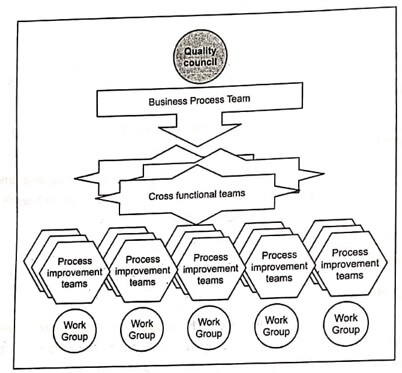What is meant by a Team and Team Work?
✔ A team can be defined as a group of people working together to achieve common objectives or goals.
✔ Teamwork is the cumulative actions of the team during which each member of the team subordinates his individual interests and opinions to fulfill the objectives or goals of the group.
✔ TQM is based on the involvement of everyone in making improvements. So working in teams is an inseparable part of the TQM environment. Nowadays teamwork is adopted universally as the organisational mechanism for involving people in quality improvements.

The benefits of teamwork include:
(ii) Improved ownership of solutions.
(iii) Improved communications.
(iv) Improved integration.
Teams can be classified into four major groups.
They are:
|
1. Process Improvement Team
✓ Process improvement team focuses its attention on improvements of a process which is already operating to a satisfactory level with agreed to tolerances.
✓ They are meant for each operation of the process or sub-process. The scope of the team is limited to work unit. Team comprise of six to ten members from the work unit.
✓ Depending upon the location of the sub-process, the internal or external supplier as well as internal or external customer is also included in the team. The life cycle of the team is temporary, because whenever the objective is reached, the team is disbanded.
2. Cross-functional Team
✓ At the top management level, the cross-functional teams are formed by certain organisations which are very successful in solving complex problems involving functions of various departments.
✓ Six to ten members are selected from various functional areas of management to constitute cross-functional teams.
✓ Cross-functional teams may discuss the complex problems and break these down into parts and refer these to departmental teams and work teams of respective functions for further solution.
✓ Feedback in the form of solutions is gathered and the problem as a whole is solved at the level of cross-functional teams. This team is also temporary.
3. Natural Work Teams
✓ Team comprise of all the members of the work unit and the team members are not volunteer; they are selected by management. Manager is also a part of the team and he is selecting the projects to be improved.
✓ Some employees may not cooperating in team work for variety of reasons. So that the manager is in a position to motivate the employees in a proper direction and make them to feel comfortable in the team.
4. Self-directed/Self-managed Work Teams
✓ A self-managing team is a group of individuals who work together continuously. These teams plan, execute and control their work to achieve a defined output. The team consist of members from the work unit except supervisor.
✓ The team coordinator is selected within the team in consultation with the top management and that may rotate among members. The team should meet daily to plan their activities and the decisions are usually made by consensus.
✓ Additional responsibilities of the teams are hiring/dismissal, performance evaluation, customer relations, supplier relations, recognition/reward and training.
✓ Fig.1 shows the use of teams throughout an organisation (Source: Dale Besterfield et al.).

Fig. 1. The use of teams throughout an organization
It can be seen from the Fig.1. that by the direction of quality council, several cross functional teams can be established. These teams address specific improvement problems of several functional areas. Within the functional areas, one or more process improvement teams may be established. In turn, one or each functional areas may establish a workgroup to address overall improvements to the particular area.
Characteristics of Successful Teams
The effective team should have certain characteristics listed in Table 1.
| 1.Sponsor: In order to have effective liaison with the quality council, there should be a sponsor. The sponsor is a person from the quality council to provide support to the organisation. |
| 2. Team Charter: A team charter is a document that defines the team’s mission, boundaries, the background of the problem, the team’s authority and duties, and resources. It also identifies the members and their assigned roles-leader, recorder, time keeper and facilitator. |
| 3. Team Composition: The size of the team should not exceed ten members except in the case of natural work teams or self-directed teams. Teams should be diversed by having members with different skills, perspectives and potential. Wherever needed, the internal and external customers and suppliers should be included as a team member. |
| 4. Training: The team members should be trained in the problem-solving techniques, team dynamics and communication skills. |
| 5. Ground Rules: The team should have separate rules of operation and conduct. Ground rules should be discussed with the members, whenever needed it should be reviewed and revised. |
| 6. Clear Objectives: The objective of the team should be stated clearly. Without the clear objective, the team functions are not to be effective. |
| 7. Accountability: The team performance is accountable: Periodic status report of the team should be given to the quality council. The team should review its performance to determine possible team process weaknesses and make improvements. |
| 8. Well-defined Decision Procedures: The decision should be made clearly at the right time by the team. |
| 9. Resources: The adequate information should be given to the team wherever needed. The team cannot be expected to perform successfully without the necessary tools. |
| 10. Trust: Management must trust the team to perform the task effectively. There must also be trust among the members and a belief in each other. |
| 11. Effective Problem-Solving: Problem-solving methods are used to make the effective decision. |
| 12. Open Communication: Open communication should be encouraged i.e., everyone feels free to speak in the team whatever they are thinking, without any interruptions. |
| 13. Appropriate Leadership: Leadership is important in all the team. Leader is a person who leads the team, motivates the team and guides the team in a proper direction. |
| 14. Balanced Participation: Everyone in a team should be involved in the team’s activities by voicing their opinions, lending their knowledge and encouraging other members to take part. |
| 15. Cohesiveness: Members should be comfortable working with each other and act as a single unit, not as individuals or subgroups. |
Role of Team Members
For effective teamwork, team members are required to perform a number of roles and responsibilities. Thus all team members should:
✓ Devote themselves to the common team goals based on a common mission and vision.
✓ Feel themselves responsible and equal.
✓ Be interested and motivated.
✓ Accept, appreciate, and respect each other.
✓ Give high priority to continuous improvement.
✓ Participate actively with the activities of the team.
✓ Offer views, opinions and ideas freely and voluntarily.
✓ Trust, support, understand and have genuine concern for other team members.
✓ Attend training seriously with a receptive attitude.
✓ Abide by the decisions taken by the team.
✓ Be responsible for their own contribution as well as for the results of the team.
✓ Encourage feedback on own behaviour.
✓ Be aware of and recognize their responsibility for improvement.
✓ Make personal improvement a routine.
| Read More Topics |
| Explain the various stages of team development |
| Leading practices for leadership |
| What are the seven steps to strategic planning? |



